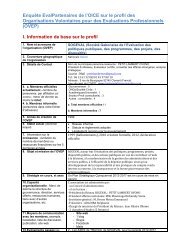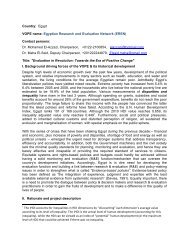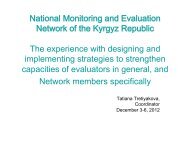6 Sandy TautIntroduction<strong>The</strong> purpose of this paper is to analyze the cross-cultural applicability of <strong>The</strong> <strong>Program</strong><strong>Evaluation</strong> <strong>Standards</strong> (Jo<strong>in</strong>t Committee on <strong>Standards</strong> for Educational <strong>Evaluation</strong>, 1994). Aspecial emphasis is placed on the <strong>Standards</strong>’ implicit cultural values because these values makethe transfer of the <strong>Standards</strong> to other value contexts (i.e., cultures) difficult. In cross-culturalpsychological literature, the concept of standards is used to def<strong>in</strong>e values, e.g., as Smith andSchwartz (1997) put it, "values serve as standards to guide the selection or evaluation ofbehavior, people, and events" (<strong>in</strong>: Berry, Segall & Kagitibasi (ed.), 1997, Vol. 3, p. 80).Accord<strong>in</strong>g to Peoples and Bailey’s (1994) sem<strong>in</strong>al anthropological textbook, values are def<strong>in</strong>edas “provid<strong>in</strong>g the ultimate standards that people believe must be upheld under practically allcircumstances” (p. 28). In addition, Smith and Schwartz (1997; <strong>in</strong>: Berry et al., Vol. 3, p. 79)state that “[…] value priorities prevalent <strong>in</strong> a society are a key element, perhaps the most central,<strong>in</strong> its culture, and the value priorities of <strong>in</strong>dividuals represent central goals that relate to allaspects of behavior.” <strong>The</strong>se researchers further note that “as standards, cultural value prioritiesalso <strong>in</strong>fluence how organizational performance is evaluated – for <strong>in</strong>stance, <strong>in</strong> terms ofproductivity, social responsibility, <strong>in</strong>novativeness, or support for the exist<strong>in</strong>g power structure”(p. 83).<strong>The</strong> first assumption derived from these statements is that <strong>The</strong> <strong>Program</strong> <strong>Evaluation</strong> <strong>Standards</strong>are values-based. <strong>The</strong> second assumption, supported by a large amount of research on culturalvalues (e.g., see Berry et al., 1997, Vol. 3, chapter 3), is that values differ across cultures:“cultures can be characterized by their systems of value priorities” (p. 80). Members of onecultural group share many value-form<strong>in</strong>g experiences and therefore come to accept similarvalues.<strong>The</strong> discrepancy <strong>in</strong> values is not only apparent between the North American and other culturesaround the world, but also, for example, with<strong>in</strong> the United States. <strong>The</strong>re, one can identify somecultural subgroups whose values deviate from "ma<strong>in</strong>stream America," e.g., Native Americans(see Miller, 1997; <strong>in</strong>: Berry et al., 1997, Vol. 1, p. 105).In contrast to values, norms are “shared ideals (rules) about how people ought to act <strong>in</strong> certa<strong>in</strong>situations, or […] toward particular other people” (Peoples & Bailey, 1994, p. 28). Norms arebased on values. In some of the <strong>Standards</strong> (e.g., Formal Agreements), the more concrete normsare reflected <strong>in</strong> lieu of the higher-level values.When analyz<strong>in</strong>g the <strong>Program</strong> <strong>Evaluation</strong> <strong>Standards</strong> it seems important to refer to the Jo<strong>in</strong>tCommittee's def<strong>in</strong>ition of standards and to address the Jo<strong>in</strong>t Committee's conclusions regard<strong>in</strong>gtheir level of generality (across cultures and even with<strong>in</strong> North America). <strong>The</strong> Jo<strong>in</strong>t Committee(1994) def<strong>in</strong>es a standard as “a pr<strong>in</strong>ciple mutually agreed to by people engaged <strong>in</strong> a professionalpractice, that, if met, will enhance the quality and practice of that professional practice, forexample, evaluation” (p. 2). <strong>The</strong> Jo<strong>in</strong>t Committee acknowledges “that standards are not allequally applicable <strong>in</strong> all evaluations” (p. 2), that they are “guid<strong>in</strong>g pr<strong>in</strong>ciples, not mechanical
Cross-Cultural Transferability of the <strong>Program</strong> <strong>Evaluation</strong> <strong>Standards</strong> 7rules” (p. 8) and, implicitly, that they are based on North American values: “<strong>The</strong>y [the<strong>Standards</strong>] def<strong>in</strong>e contemporary ideas of what pr<strong>in</strong>ciples should guide and govern evaluationefforts” (pp. 17-18). In a section on guidel<strong>in</strong>es for application of the <strong>Standards</strong>, the third step isto “clarify the context of the <strong>Program</strong> <strong>Evaluation</strong>” (p. 11), the cultural context unquestion<strong>in</strong>glybe<strong>in</strong>g of major importance. Stufflebeam (1986), Chair of the Jo<strong>in</strong>t Committee from its birth <strong>in</strong>1975 until 1988, notes that “their [the <strong>Standards</strong>’] utility is limited, especially outside the UnitedStates” (p. 18). Evaluators have called for more research on their transferability (e.g., Nevo,1984, p. 386). <strong>The</strong> follow<strong>in</strong>g paper is an <strong>in</strong>vestigation along this dimension.With evaluation recently becom<strong>in</strong>g a stronger professional field <strong>in</strong> many countries, <strong>Standards</strong> forprofessional conduct also become an important issue. <strong>The</strong> process of develop<strong>in</strong>g <strong>Standards</strong> iseffortful and cost-<strong>in</strong>tensive (see Jo<strong>in</strong>t Committee, 1994, pp. xvi-xviii; Stufflebeam, 1986, pp. 2).<strong>The</strong>refore, it is only logical that evaluators from different countries turn to the <strong>Program</strong><strong>Evaluation</strong> <strong>Standards</strong> as a model for their own work. <strong>The</strong> <strong>Standards</strong> have been translated <strong>in</strong>toGerman, after Beywl (1996, 1999) concluded that – with m<strong>in</strong>or adaptations – they aretransferable to the German cultural context. <strong>The</strong> Swiss <strong>Evaluation</strong> Society developed <strong>Standards</strong>closely follow<strong>in</strong>g the North American model (see SEVAL-<strong>Standards</strong>, Schweizerische<strong>Evaluation</strong>sgesellschaft, 1999). However, the Schweizerische <strong>Evaluation</strong>sgesellschaft did notspecifically address the degree of transferability of the <strong>Standards</strong>. Neither did the Spanishtranslation of the <strong>Standards</strong> (Villa, 1998). Dur<strong>in</strong>g a 1998 UNICEF <strong>Evaluation</strong> Workshop <strong>in</strong>Nairobi, Kenya, a focus group discussion dealt with the applicability of the <strong>Standards</strong> <strong>in</strong> Africancultures (Russon & Patel, 1999, p. 4). Of the n<strong>in</strong>e African evaluators, the majority found the<strong>Standards</strong> to be transferable if some modifications were undertaken. In their eyes, the <strong>Standards</strong>are not laden with values <strong>in</strong>compatible with African values. Dur<strong>in</strong>g the discussion, theparticipants suggested adaptations of twelve <strong>Standards</strong> (see Russon & Patel, 1999, pp. 5). Am<strong>in</strong>ority held that African Evaluators should develop their own <strong>Standards</strong>. <strong>The</strong> <strong>Standards</strong> havealso been used <strong>in</strong> Israel (see Nevo, 1984; Lewy, 1984), Brazil (see Rodrigues de Oliveira &Gomes-Elliot, 1983), and Sweden (see Marklund, 1984). <strong>The</strong>se authors conclude that theimportation of the <strong>Standards</strong> requires at least some adaptation to fit the host culture but <strong>in</strong> fewcountries has the transferability issue been addressed <strong>in</strong> detail. Consequently, an <strong>in</strong>-depthanalysis of the <strong>Standards</strong>’ general cross-cultural transferability is crucial and overdue.<strong>The</strong> present paper does not <strong>in</strong>vestigate the likelihood that various cultures meet the <strong>Standards</strong>based on their cultural idiosyncrasies. Instead, the values the <strong>Standards</strong> are based on will beexam<strong>in</strong>ed. It will be shown that <strong>in</strong> certa<strong>in</strong> cultures these values may limit the applicability of the<strong>Standards</strong> as guid<strong>in</strong>g pr<strong>in</strong>ciples for evaluators (see Beywl, 1999; Smith et al., 1993; Jang, 2000).In this context, it is important to differentiate between <strong>in</strong>digenous <strong>Standards</strong> emerg<strong>in</strong>g fromwith<strong>in</strong> different cultures, cross-cultural <strong>Standards</strong> <strong>in</strong>tended for evaluators work<strong>in</strong>g <strong>in</strong> similarcultures (or with multicultural stakeholders), and ubiquitous <strong>Standards</strong> <strong>in</strong>tended to fit allcultures. <strong>The</strong> latter <strong>Standards</strong> might need to be highly general or vague to fit all possiblecontexts, which likely results <strong>in</strong> less specific direction and therefore less utility of these<strong>Standards</strong>. As po<strong>in</strong>ted out above, <strong>Standards</strong> are per se values-based and therefore culturespecific.Consequently, it seems that ‘cover<strong>in</strong>g up’ their orig<strong>in</strong> by add<strong>in</strong>g statements that stressgenerality can only work at the expense of the <strong>Standards</strong>’ effectiveness as guid<strong>in</strong>g pr<strong>in</strong>ciples.
- Page 1 and 2: The Program Evaluation Standardsin
- Page 3 and 4: The editor acknowledges the valuabl
- Page 5 and 6: ForewordOn February 18-20, 2000, th
- Page 7 and 8: Hopefully, this volume will contrib
- Page 9: 5Cross-Cultural Transferabilityof T
- Page 13 and 14: Cross-Cultural Transferability of t
- Page 15 and 16: Cross-Cultural Transferability of t
- Page 17 and 18: Cross-Cultural Transferability of t
- Page 19 and 20: Cross-Cultural Transferability of t
- Page 21 and 22: Cross-Cultural Transferability of t
- Page 23 and 24: Cross-Cultural Transferability of t
- Page 25 and 26: Cross-Cultural Transferability of t
- Page 27 and 28: Cross-Cultural Transferability of t
- Page 29 and 30: Cross-Cultural Transferability of t
- Page 31: Cross-Cultural Transferability of t
- Page 34 and 35: 30 Nick L. Smith, Saviour Chircop a
- Page 36 and 37: 32 Nick L. Smith, Saviour Chircop a
- Page 38 and 39: 34 Nick L. Smith, Saviour Chircop a
- Page 40 and 41: 36 Nick L. Smith, Saviour Chircop a
- Page 42 and 43: 38 Nick L. Smith, Saviour Chircop a
- Page 44 and 45: 40 Nick L. Smith, Saviour Chircop a
- Page 46 and 47: 42 Soojung Jangyears. Due to the sc
- Page 48 and 49: 44 Soojung JangThis test-based sele
- Page 50 and 51: 46 Soojung JangTable 1. Descriptive
- Page 52 and 53: 48 Soojung JangU2 Evaluator Credibi
- Page 54 and 55: 50 Soojung Janggenerous to foreigne
- Page 56 and 57: 52 Soojung Jangfeelings. This partl
- Page 58 and 59: 54 Soojung JangReporting Informatio
- Page 60 and 61:
56 Soojung JangU4 Values Identifica
- Page 62 and 63:
58 Soojung JangReferencesBecker, C.
- Page 64 and 65:
60Standards for Evaluation:On the W
- Page 66 and 67:
62 Wolfgang BeywlThe advantage of t
- Page 68 and 69:
64 Wolfgang BeywlA more direct way
- Page 71 and 72:
67Evaluating Evaluations: Does the
- Page 73 and 74:
Evaluating Evaluations 69Bussmann 1
- Page 75 and 76:
Evaluating Evaluations 71• Housin
- Page 77 and 78:
Evaluating Evaluations 73Table 1: C
- Page 79 and 80:
Evaluating Evaluations 75• Contra
- Page 81 and 82:
Evaluating Evaluations 77References
- Page 83 and 84:
Evaluating Evaluations 79Raven, J.
- Page 85 and 86:
81Evaluation StandardsRecommended b
- Page 87 and 88:
Evaluation Standard Recommended by
- Page 89 and 90:
Evaluation Standard Recommended by
- Page 91 and 92:
Evaluation Standard Recommended by
- Page 93 and 94:
Evaluation Standard Recommended by
- Page 95 and 96:
Evaluation Standard Recommended by
- Page 97 and 98:
Evaluation Standard Recommended by
- Page 99 and 100:
Evaluation Standard Recommended by
- Page 101 and 102:
Evaluation Standard Recommended by
- Page 103 and 104:
Evaluation Standard Recommended by
- Page 105 and 106:
Evaluation Standard Recommended by
- Page 107 and 108:
103AnnexThe complete list of the or
- Page 109:
Annex 105A4 Defensible Information






